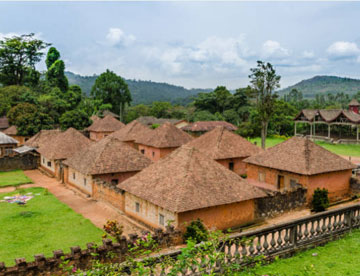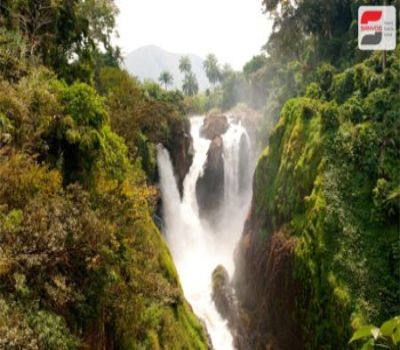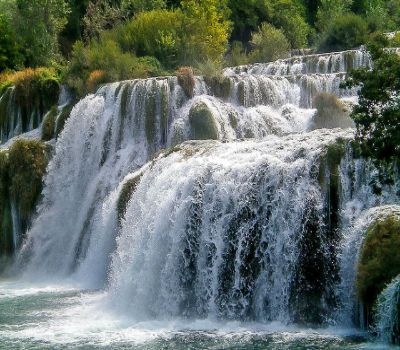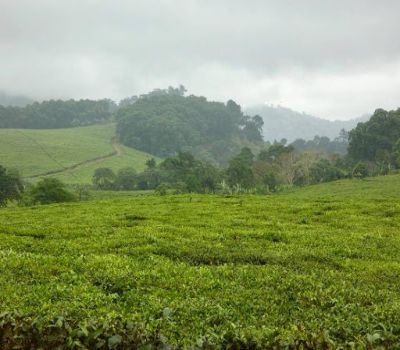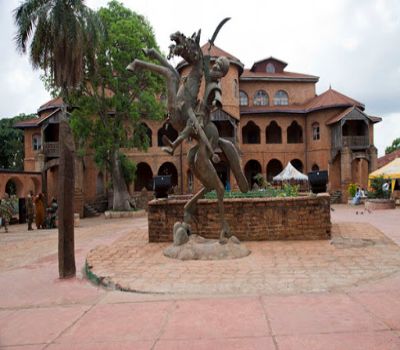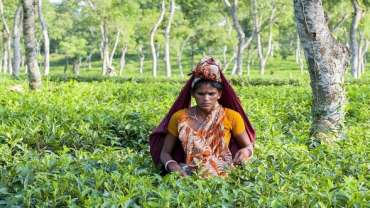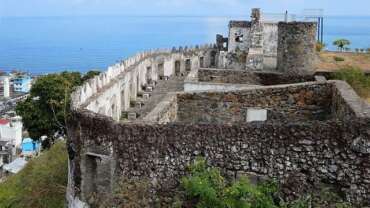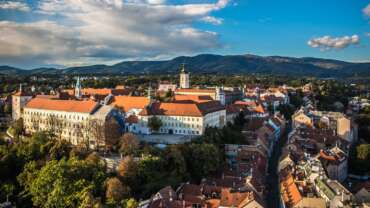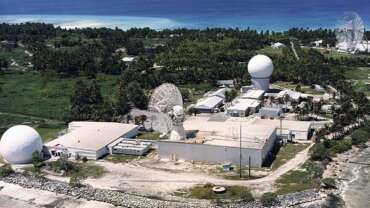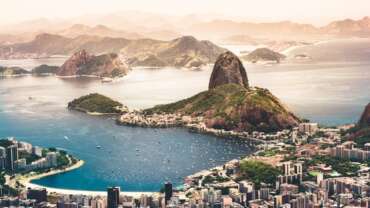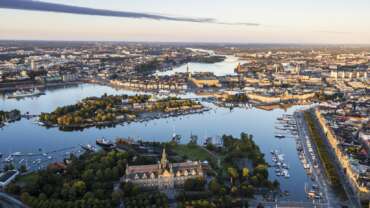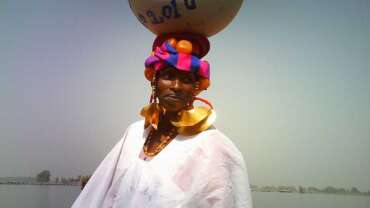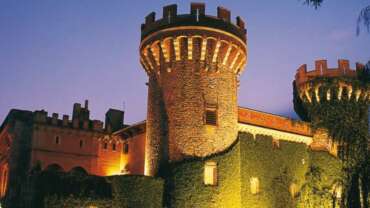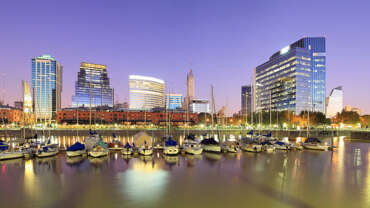Cameroon - All of Africa in a single Country
Cameroon, on the Gulf of Guinea, is a Central African country of varied terrain and wildlife. Its inland capital, Yaoundé, and its biggest city, the seaport Douala, are transit points to ecotourism sites as well as beach resorts like Kribi – near the Chutes de la Lobé waterfalls, which plunge directly into the sea – and Limbe, where the Limbe Wildlife Centre houses rescued primates.
Like the majority of African countries, Cameroon remains relatively unknown to the general public. Many travelers still have a confused image of the typical features among tourist continental destinations.
Nevertheless, Cameroon stands out with a genuine identity expressing diversity and stability, modernity and traditions, dynamism and calm, at once. In short, the country concentrates all the beauties of Africa; which explains why people consider that nobody could really discover Africa without having visited Cameroon. The country is full of melting and contrasting views, which provide tourists with a unique spectacle. This ancestral land relies on a symbiosis between sea and desert, waterfalls and Sahara area, temperate climate in the South and great heat in the North.
The relation between tribal societies and modern cities, the exceptional variety of the flora and fauna, the cohabitation of traditional and democratic leadership…etc, this always gives tourists the impression that they are visiting several countries at the same time. During the trip, they may feel in harmony with art, nature and people, even give up to the Soul of Africa before finding themselves again.
The History of Cameroon
Early history
The earliest inhabitants of Cameroon were probably the Baka (Pygmies). They still inhabit the forests of the south and east provinces.[1] Bantu speakers originating in the Cameroonian highlands were among the first groups to move out before other invaders. The Mandara kingdom in the Mandara Mountains was founded around 1500 and erected fortified structures, the purpose and exact history of which are still unresolved. The Aro Confederacy of Nigeria may have had presence in western (later called British) Cameroon due to migration in the 18th and 19th centuries.
During the late 1770s and the early 19th century, the Fulani, a pastoral Islamic people of the western Sahel, conquered most of what is now northern Cameroon, subjugating or displacing its largely non-Muslim inhabitants.
Although the Portuguese arrived on Cameroon’s doorstep in the 16th century, malaria prevented significant European settlement and conquest of the interior until the late 1870s, when large supplies of the malaria suppressant, quinine, became available. The early European presence in Cameroon was primarily devoted to coastal trade and the acquisition of slaves. The northern part of Cameroon was an important part of the Muslim slave trade network. The slave trade was largely suppressed by the mid-19th century. Christian missions established a presence in the late 19th century and continue to play a role in Cameroonian life.
Colonization
Beginning on July 5, 1884, all of present-day Cameroon and parts of several of its neighbours became a German colony, Kamerun, with a capital first at Buea and later at Yaoundé.
The Imperial German government made substantial investments in the infrastructure of Cameroon, including the extensive railways, such as the 160-metre single-span railway bridge on the South Sanaga River branch. Hospitals were opened all over the colony, including two major hospitals at Douala, one of which specialised in tropical diseases (the Germans had discovered the 1912, wrote in an official report in 1919 that the population of Kamerun had increased significantly. However, the indigenous peoples proved reluctant to work on these projects, so the Germans instigated a harsh and unpopular system of forced labour.[2] In fact, Jesko von Puttkamer was relieved of duty as governor of the colony due to his untoward actions toward the native Cameroonians.[3] In 1911 at the Treaty of Fez after the Agadir Crisis, France ceded a nearly 300,000 km² portion of the territory of French Equatorial Africa to Kamerun which became Neukamerun, while Germany ceded a smaller area in the north in present day Chad to France.
In World War I the British invaded Cameroon from Nigeria in 1914 in the Kamerun campaign, with the last German fort in the country surrendering in February 1916. After the war this colony was partitioned between the United Kingdom and France under a June 28, 1919 League of Nations mandates (Class B). France gained the larger geographical share, transferred Neukamerun back to neighboring French colonies, and ruled the rest from Yaoundé as Cameroun (French Cameroons). Britain’s territory, a strip bordering Nigeria from the sea to Lake Chad, with an equal population was ruled from Lagos as Cameroons (British Cameroons). German administrators were allowed to once again run the plantations of the southwestern coastal area. A British Parliamentary Publication, Report on the British Sphere of the Cameroons (May 1922, p. 62-8), reports that the German plantations there were ‘as a whole . . . wonderful examples of industry, based on solid scientific knowledge. The natives have been taught discipline and have come to realise what can be achieved by industry. Large numbers who return to their villages take up cocoa or other cultivation on their own account, thus increasing the general prosperity of the country.’
Towards Independence (1955-1960)
On 18 December 1956, the outlawed Union of the Peoples of Cameroon (UPC), based largely among the Bamileke and Bassa ethnic groups, began an armed struggle for independence in French Cameroon. This rebellion continued, with diminishing intensity, even after independence until 1961.[4] Estimates of death from this conflict vary from thousands to hundreds of thousands.
Legislative elections were held on 23 December 1956 and the resulting Assembly passed a decree on 16 April 1957 which made Cameroon a State. It took back its former status of associated territory as a member of the French Union. Its inhabitants became Cameroonian citizens, Cameroonian institutions were created under the sign of parliamentary democracy. On 12 June 1958 the Legislative Assembly of Cameroon asked the French government to: ‘Accord independence to the State of Cameroon at the ends of their trusteeship. Transfer every competence related to the running of internal affairs of Cameroon to Cameroonians`. On 19 October 1958 France recognized the right of her United Nations trust territory of the Cameroons to choose independence.[5] On 24 October 1958 the Legislative Assembly of Cameroon solemnly proclaimed the desire of Cameroonians to see their country accede full independence on 1 January 1960. It enjoined the government of Cameroon to ask France to inform the General Assembly of the United Nations, to abrogate the trusteeship accord concomitant with the independence of Cameroon.On 12 November 1958 having accorded Cameroon total internal autonomy and thinking that this transfer no longer permitted them to assume its responsibilities of trust territory for an unspecified period, the government of France asked the United Nations to grant the wish of Cameroonians. On 15 December 1958 the United Nations’ General Assembly took note of the French government’s declaration according to which Cameroon which was under French administration would gain independence on 1 January 1960, thus marking an end to the trusteeship period (Resolution 1282. XIII).[6][7] On 13 March 1959 the United Nations’ General Assembly resolved that the UN Trusteeship Agreement with France for Cameroon would end when Cameroon became independent on 1 January 1960 (Resolution 1349. XIII).
Cameroon After Independence
French Cameroon achieved independence on January 1, 1960 as the La Republique du Cameroun. After Guinea, it was the second of France’s colonies in Sub-Saharan Africa to be granted independence. The following year, on October 1, 1961, the largely Muslim northern two-thirds of British Cameroons voted to join Nigeria; the largely Christian southern third, Southern Cameroons, voted to join with the Republic of Cameroon to form the Federal Republic of Cameroon. The formerly French and British regions each maintained substantial autonomy. Ahmadou Ahidjo, a French-educated Fulani, was chosen president of the federation in 1961. Ahidjo, relying on a pervasive internal security apparatus, outlawed all political parties but his own in 1966. He successfully suppressed the continuing UPC rebellion, capturing the last important rebel leader in 1970. In 1972, a new constitution replaced the federation with a unitary state called the United Republic of Cameroon. This is the major cause of tension between the French and English speaking areas of Cameroon. Southern Cameroonians feel the agreement at the Foumban constitution conference is not respect.
Although Ahidjo’s rule was characterised as authoritarian, he was seen as noticeably lacking in charisma in comparison to many post-colonial African leaders. He didn’t follow the anti-western policies pursued by many of these leaders, which helped Cameroon achieve a degree of comparative political stability and economic growth.
Ahidjo resigned as president in 1982 and was constitutionally succeeded by his Prime Minister, Paul Biya, a career official from the Beti-Pahuin ethnic group. Ahidjo later regretted his choice of successors, but his supporters failed to overthrow Biya in a 1984 coup. Biya won elections in 1983 and 1984 when the country was again named the Republic of Cameroon. Biya has remained in power, winning multiparty elections in 1992, 1997, and 2004. His Cameroon People’s Democratic Movement (CPDM) party holds a sizeable majority in the legislature.
On August 15, 1984, Lake Monoun exploded in a cataclysmic eruption that released carbon dioxide, suffocating 37 people to death. On August 21, 1986, another cataclysmic eruption at Lake Nyos killed as many as 1,800 people and 3,500 livestock. The two disasters are the only recorded instances of cataclysmic eruptions.
Cameroon - A Land of Contrasted Relief
Cameroon is located in the bay of the Gulf of Guinea, just above the Equator and extends from Lake Chad to the Atlantic coast.
Cameroon shares its frontiers with various countries:
• Equatorial Guinea to the South West
• Gabon, to the South-East
• Congo to the south,
• Central African Republic, to the East
• Chad to the North and
• Nigeria to the west.
• Surface area: 475,442 km2
• Maximum altitude: 4,070 m (Mount Cameroon)
• Political capital: Yaoundé, at 700m above sea level and 250km from the coast.
• Principal cities include Douala, Garoua, Maroua, Ngaoundéré, Bafoussam, Bamenda, Bertoua, Kribi, Ebolowa, Buéa, Edéa and Nkongsamba.
One country, two climates.
Cameroon has two types of climates. [ Rainy Season and Dry Season ]
– In the North and Far North: Tropical climate with a light rainy season and high temperatures (average 30° C) increasing as you advance towards the arid lands.
– In the South, the western high plateaus and coastal plains are influenced by sea and relief with heavy and regular rains and constant temperatures (average 26° C).
According to the Guiness Book of World Records, the town of Debuncha in the coastal SouthWest Region near Limbe, is the second rainest place in the World.
A luxuriant vegetation
The natural beauty and diversity invites people to a stronger respect of environment protection. Therefore, tourists have a great opportunity to find out their harmony with Nature and its treasure. Because vegetation reflects climate, it is humid in the luxuriant tropical forests of the South, which represents more than one third of the total area.
A renewed landscape
At first glance, the tourist is surprised by the beautiful diversity of Cameroonian landscape. His curiosity is excited along the trail of discovery, from picturesque mountains to grey-sandy beaches.
In the North, lunar landscapes like the Kapsikis outstand over the surrounding steppes. Irrigated by great rivers, the South and East tropical forests dominate the territory.
In the South coast, near Kribi, The Cameroonian Côte DAzur, tourists really appreciate the pleasure of the vast sandy beaches shaded by coconut trees.
Finally, Mount Cameroon in the South West, an active volcano towering over the Ocean, offers its black-sandy beaches at Limbe along with other beautiful colors of Cameroon.
Free and protected animals
Cameroon is a real paradise for animals in the wild. The country concentrates the best fauna of Central Africa, through its 9 natural parks and other numerous reserves. Such an exceptional resource stands for a treasure to all tourist in search of The Soul of Africa.
Their dreams become true in the northern savannah when they meet lions, giraffes, elephants, rhinoceros …etc. Down in the South, forests and rivers full of funny gorillas are waiting for their visits.
Cameroon - Cultural Attractions Overview
Presentation of Cameroon
Cameroon is situated in Central Africa, at juncture of the Gulf of Guinea.
It is bounded on the North by Chad, on the East by the Central Africa Republic, on the South by Congo, Gabon and Equatorial Guinea and on the West by Nigeria.
Cameroon is a country with several major towns, amongst which are YAOUNDE, the political capital of the country with about one million inhabitants. DOUALA, which is the major economic city, has more than two million inhabitants. The other main towns are GAROUA, BAFOUSSAM, MAROUA, BAMENDA etc.
Population
Cameroon has more than 240 tribes which are found in three main ethnic groups; Bantus, Semi-Bantus and Sudanese. The number of national languages spoken in the country is more than 240. The most notable tribes are:
BANTUS: Beti, Bassa, Bakundu, Maka, Douala, Pygmies……
SEMI-BANTUS: Bamileke, Gbaya, Bamoun, Tikar……..
SUDANESE: Fulbe, Mafa, Toupouri, Shoa-Arabs, Moundang, Massa, Mousgoum….
Languages
French and English are the official languages, which are spoken by 70% and 30% of the population respectively. Spanish and German are equally spoken by a few city-dwellers.
Public Holidays
Religious: Good Friday, Easter, Ascension, Pentecost, Assumption, Christmas, End of Fasting, Feast of the Ram.
Secular: New Year, Youth Day (11th February), Labour Day (1st May), National Day (20th May).
Touristic Attractions
Besides the shooting season which is practised in the northern part of the country from November to May, all other tourist activities can be undertaken throughout the whole year.
Climate
Dry and rainy seasons alternate in the country, with the dry season generally going from November to April. Temperatures range from 23 to 31°C in January to 21 to 35°C in July.
ISO code is CM
Time: 1 behind GMT
Religion
Cameroon is a secular state. Two major religions are Christianity and Islam. Animism is also widely practiced.
Cameroon - The Best Place to visit in Africa

Cameroon is among the blessed countries in Africa often called ‘Africa miniature’, as it contains the diversity of all of Africa within its borders. Its varied terrain, cultural diversity and modernity make it a veritable traveller’s destination – in fact, it is said that if you haven’t been to Cameroon, you haven’t been to Africa. Here are just nine reasons to visit this unique country .
Beautiful cities
Central Africa might not be famous for its cities, but Cameroon’s capital, Yaounde, and commercial capital, Douala, are worth a day or two of sightseeing. Yaounde is immaculately planned to be spread over seven hills, meaning that the numerous buildings are separated by stretches of lush green and rising terrain. In addition to its layout, the city is clean and safe, with several places to visit, including ancient monuments and museums. Coastal Douala is a great place to visit to experience modern Cameroon and has a lively dining and nightlife scene.



